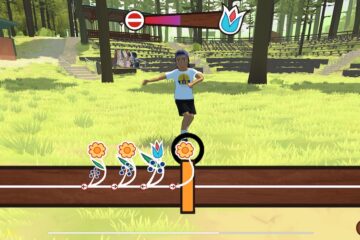Parks outreach as big as all outdoors

WPBT literally introduced the Roberts family to Florida’s big national park. Clockwise above: George Jr., Shanda, George III, Shawn Jarrett and Shadaisha. (Family photo.)
Doing more than her share for public TV’s $6 million outreach project surrounding Ken Burns’ National Parks series, Shanda Roberts lost her shoe in the muck of the Everglades.
Reaching to retrieve it, she bent down and hit her head on a tree. A public TV crew captured the disconcerting moment — which was lighthearted compared to the time they got her into a canoe.
The Roberts family’s camping trip was a South Floridian element in the varied nationwide extravaganza surrounding the six-part Burns series, which debuts on PBS Sept. 27. The effort is one of public TV’s largest ever, even more extensive than for Burns’ World War II series two years ago.
WPBT in South Florida treated Roberts and her family to a weekend at the swampy national park and stardom in a sort of local reality show-one of dozens of locally produced programs.
More than 100 stations are organizing writing workshops, multicultural happenings and other events and projects, many in partnership with the National Park Service. They’re working with community groups to raise awareness of challenges and opportunities that visitors with disabilities have in the parks. They’re providing young filmmakers with small, inexpensive video cameras and direct access to advice from Burns. It’s all designed to lure folks into the parks, visitors who either aren’t aware of what the parks have to offer or are intimidated by the massive scale of their great outdoors.
Events often tie into appearances by Burns and co-producer Dayton Duncan, who are visiting more than 45 communities nationwide to speak about the much-anticipated series. It’s a history of the national park system from the Civil War to the 1980s, focusing on the diverse people who dreamed, planned and toiled to create it.
Specifically targeted in the outreach efforts are traditionally underserved audiences. One major aspect is the Untold Stories Project, a national project consisting of five 10-minute docs, a 30-minute companion film and text autobiographies covering the role of minorities in the birth of the parks. Included are African Americans, Asian Americans, Hispanic Americans and Native Americans. Those materials will be featured on multiple platforms across the country.
Anne Harrington, director of interactive media and engagement at WETA—the station overseeing the massive engagement enterprise—said Untold Stories enables viewers to get a deeper, more contemporary look at specific parks mentioned in the doc.
She cited the film’s segment on the Manzanar National Historic Site in California, one of 10 camps where more than 110,000 Japanese Americans were forcibly housed during World War II. “The Untold Stories mini-documentary shows a pilgrimage to the site that still happens every year,” Harrington said.
Much of the funding for the outreach was provided by the Evelyn and Walter Haas, Jr. Fund, a family foundation in San Francisco.
- In 2004 the Haas Fund contributed $1.5 million for film production, including $150,000 for research and development of “stories focusing on people of color who had an impact on the history of the parks,” said fund spokeswoman Maya Trabin. That grew into Untold Stories — what Trabin called the “backbone” of the outreach.
- In 2007, the fund pitched in an additional $2.5 million to support outreach — a grant believed to be the largest for such efforts in public TV history.
CPB invested just over $2.4 million. The National Park Service, which enthusiastically cooperated with Burns, also provided grants to 36 parks.
WETA regranted some of the funds: Ten pubTV stations received project grants of $15,000 to $20,000. Fifty others were granted $7,500 each. “We wanted stations [serving] highly diverse populations,” Harrington said.
Snakes and alligators, oh my
Several stations are using those funds quite creatively.
Jack Kelly, v.p. of production at WPBT, contacted a representative of Everglades National Park. “We talked about working together on how to get rid of misconceptions about national parks, specifically the Everglades,” Kelly said.
A plan took root: In reality-show style, a video crew would follow a family camping for a weekend—people who had never been to a park and certainly never considered sleeping in the great outdoors.
That’s how Shanda Roberts came to wallow in the Everglades. Just two months ago, Roberts was recruited through her daycare provider, who had heard the station was looking for a family to camp. “She said, ‘You’d be perfect!’ and I just kept on walking,” said Roberts, of Miami.
“Camping? Nooooo, not where there’s alligators and bugs and bears,” Roberts told her. But by the end of the day, she’d been persuaded to give it a try. “I called my husband, and he was cool with it,” she said.
The station decided the Robertses were perfect. They’re “very spontaneous, very real,” Kelly said.
So Roberts; her husband, George Jr.; and children Shadaisha, 11; George Roberts III, 9; and Shawn Jarrett, 11, set off one sunny Saturday morning in April with Kelly’s film crew in tow.
The family had the assistance of their own park ranger as well as all the supplies they needed.
They pitched a tent. “Oh my God, it took an hour, and it was hot,” Roberts said. They made a fire and cooked hamburgers. They hiked. They canoed. They learned about snakes. They took a two-hour bike ride. They saw exotic birds-and alligators.
“We went back to see the alligators at night, because during the day they’re still,” Roberts said. “It was pitch black. We had flashlights. We had to be quiet.” Soon they realized there was a specimen of low-slung wildlife very nearby. “He was right in front of us. I was petrified.”
Providing unintentional reality-show slapstick for the camera crew was fine with the family. “After a few hours, it was like they weren’t there,” Roberts said.
At least once she wondered whether agreeing to the full-reality treatment was a big mistake. “I cried when we went canoeing,” she said. “Out there on the water, the canoe was so small, my husband was steering, and I was sitting with my daughter. I couldn’t get comfortable.”
Finally, time came for some shuteye. Roberts thought she’d never fall asleep, but she snoozed soundly right through the night. She crawled out of her tent around 5 a.m. Sunday.
“It was so peaceful,” she said. “Amazing. No cars, no horns, no airplanes.” All she could hear were small birds, water burbling and her family breathing softly.
The experience changed her family’s attitude about the park. “We’re 20 minutes from the Everglades and had never gone there,” Roberts said. “But now the kids want to go back. We probably will, once it gets cooler. ”
Kelly said the station hopes to build a website around the Roberts’s reality documentary.
“The park is interested in continuing with different families, so there could be a follow-up or more,” he added. The camera crew and family explored about six square miles of the park’s 1.4 million acres.
“Jam-packed” days of events
South Dakota Public Broadcasting staffers were busier than usual May 3. “We had four events that one day,” said Sherri Rodgers-Conti, director of education and outreach. Two were at Mount Rushmore.
First up was the Information Expo and Heritage Exchange. Cultural groups and all six of the state’s national parks participated. There was music and dancing by the Lakotas, the Sons of Norway, the Germans from Russia Heritage Society. Filmmaker Duncan and Native American Gerard Baker, a longtime Park Service employee featured in the film, circulated among visitors.
Then came “Revealing Voices from the Past,” a workshop on historical writing. A local author and a professor spoke. Duncan stopped by to talk about his career and answer questions. Dozens attended.
From there the action shifted to Rapid City for a reception at the Prairie Edge Trading Co. & Galleries. Some 150 special guests—pubcasting supporters, dignitaries, politicians—noshed and chatted with Duncan and Gerard.
To cap off the day, about 450 people attended a screening of highlights from the doc.
“It was a jam-packed 12 hours,” Rodgers-Conti said.
KQED in San Francisco has also had several well-attended events so far. “We had about 500 people for a four-hour conference and screening,” said Scott M. Walton, director of communications. The station also organized Burns’s recent press conference at which he announced he was donating his research archives to the National Park Service, as well as a 45-minute film, This Is America.
“And we’re reaching out to diverse populations,” including people with disabilities, Walton said. The station is partnering with the City of San Francisco to host screenings and discussion groups about disability-access issues.
Yosemite National Park, 150 miles east of San Francisco, “has been a leader in this,” Walton said. The Park Service has created pathways that made Yosemite’s features more accessible for visitors with wheelchairs and walkers.
KCTS in Seattle is busy, too, with events including a screening with Burns and Duncan that drew a crowd of around 2,200 on April 20.
The station is reaching out to young filmmakers. On April 19, Burns and Duncan took a ferry to IslandWood, a 255-acre outdoor learning center on Bainbridge Island. They met some 15 teenagers to discuss documentary filmmaking as well as the importance of the parks. The station lent simple, cheap Flip cameras to the kids, coached them on filming and editing, and sent them off to create their stories. KQED professionals shot their stories of the day, too.
“The great thing is this is a combined effort between us and the park system to get urban kids into the parks,” said Stefanie Malone, KCTS outreach manager. “Although youth might be plugged into today’s current technologies, they aren’t creating meaningful relationships in nature.”
WETA’s Harrington said projects created through the outreach will live on after the broadcast dates.
“Ken’s projects have a life of their own,” she said. “I still get calls on a regular basis about The Civil War.”
Thanks to the partnerships between the National Park Service and the stations — many of which are donating documentaries they’ve filmed to their local parks — the project will find “a whole new life post-broadcast,” she predicted.
EARLIER ARTICLES
Ken Burns said in March 2009 that he’ll proceed with his films as planned despite General Motors’ withdrawal as a major sponsor. The contract covered about 35 percent of Burns’ production budgets.
LINKS
The PBS website for The National Parks: America’s Best Idea. There are video previews, social networking links, postcards to send, wallpapers and widgets.
Information on community engagement efforts related to the series.
In this video, Ken Burns and Dayton Duncan discuss their series before an audience of the National Park Foundation, the charitable partner of the National Park Service.
South Dakota Public Broadcasting’s site contains many video and audio extras on the state’s parks.





